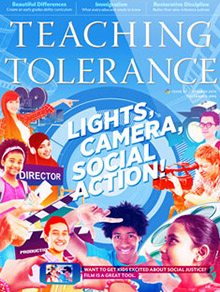Teaching Tolerance magazine offers road map to help teachers create anti-bias curriculum
A first-of-its-kind road map from Teaching Tolerance that points the way for teachers to implement anti-bias education at every grade level will help them build classroom environments that encourage diversity, equity and justice, according to the latest issue of Teaching Tolerance magazine, released today.
A first-of-its-kind road map from Teaching Tolerance that points the way for teachers to implement anti-bias education at every grade level will help them build classroom environments that encourage diversity, equity and justice, according to the latest issue of Teaching Tolerance magazine, released today.
The Teaching Tolerance Anti-Bias Framework helps teachers address the complex concepts of identity, diversity, justice and action through a set of anchor standards and grade-level outcomes.
The Summer 2014 issue of Teaching Tolerance is available online. Readers can subscribe to an iPad version, with extra digital content, here.
“The Teaching Tolerance Anti-Bias Framework shows teachers what anti-bias education looks like from kindergarten through high school,” said Teaching Tolerance Director Maureen Costello. “It’s a first-of-its kind guide to embedding social justice into the curriculum and places strong emphasis on student activism.”
Student action is at the heart of “Lights, Camera, Social Action!” The cover story explores how viewing – and making – documentary films can get students engaged in social justice and inspire them to use film to bring about change.
“Raising Inequity” reveals how much our public schools rely on private fundraising and examines how the system perpetuates inequity. It shows how communities with fewer financial resources – and greater needs – often end up watching the education spending gap grow wider.
The magazine also examines restorative discipline practices, an approach that looks to students to help make schools safer. Another article profiles a first-grade teacher who introduced his students to people with differing abilities, a group often overlooked in discussions about diversity and civil rights. In this issue, teachers will also find a guide that puts the immigration debate in historical context.
Teaching Tolerance magazine, published three times a year, is the nation’s leading journal serving educators on diversity issues. It is distributed free of charge to more than 410,000 educators nationwide.


